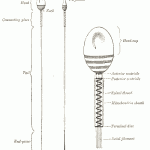November 23rd, 2011 by Harriet Hall, M.D. in Opinion
2 Comments »

A recent announcement is likely to generate a lot of controversy. The Advisory Committee on Immunization Practices of the CDC has recommended that boys and young men be vaccinated against human papillomavirus (HPV). Previously the guidelines said boys “could” be given the HPV vaccine. Now they have recommended that boys age 11 to 12 “should” be vaccinated, as well as boys age 13 to 21 who have not already had the full series of 3 shots. The vaccine can also be given to boys as young as 9 and to young men age 22 to 26.
The vaccine was originally promoted as a way to prevent cervical cancer. Boys don’t have a cervix, so why should they be subjected to a “girl’s” vaccine? There are some good science-based reasons:
- Boys can transmit the virus to female sex partners later in life, leading to cervical cancer in women.
- More importantly, boys themselves can also be directly harmed by the virus. It can cause genital warts, cancer of the head and neck (tongue, tonsils and throat), anal and penile cancer, respiratory papillomatosis, and giant condyloma of Buschke and Lowenstein. In rare cases, immunocompromised patients can develop epidermodysplasia verruciformis.
- HPV has even been Read more »
*This blog post was originally published at Science-Based Medicine*
September 30th, 2011 by RyanDuBosar in Research
No Comments »


Married men who have no children have a 17% higher risk of dying from cardiovascular disease after the age of 50 than men with two or more children. But whether that’s because of a physical cause, a sociological effect or self-selection (sick people may choose not to have kids) isn’t known.
To determine if the number of kids predicts cardiovascular death, researchers used data from the NIH-AARP Diet and Health Study of nearly 135,000 men ages 50 to 71 without prior cardiovascular disease who were followed-up for an average of 10 years. That study mailed 3.5 million questionnaires from 1995 through 1996 to AARP members living in California, Florida, Pennsylvania, New Jersey, North Carolina, and Louisiana or in Atlanta or Detroit. Nearly 586,000 people returned the questionnaire, which underwent follow-up surveys in 1996-1997 and 2004-2006. Results appeared online Sept. 26 in the journal Human reproduction.
Almost all (92%) men had Read more »
*This blog post was originally published at ACP Internist*
August 26th, 2011 by RyanDuBosar in Research
No Comments »

Women gain weight after marriage and men after divorce, especially among those over 30, likely the result of “weight shock” to people’s routines in physical activity and diet, sociologists reported.
The research, led by a sociology doctoral student at The Ohio State University, was presented at a roundtable on Marriage and Family at the annual meeting of the American Sociological Association. They used data from the National Longitudinal Survey of Youth ’79, a nationally representative sample of men and women ages 14 to 22 in 1979. The same people were surveyed every year up to 1994 and every other year since then, reported a press release.
Data on more than 10,000 people surveyed from 1986 to 2008 was used to determine Read more »
*This blog post was originally published at ACP Internist*
January 26th, 2010 by DrCharles in Better Health Network, Health Tips
No Comments »

 Today NPR ran a story about fierce competition and cooperation among mouse sperm cells trying to fertilize an ovum. Apparently spermatozoa from the same male will often clump together, wiggling their flagella in a collective swim that accelerates the group faster towards an egg. In the race to be the first sperm to fertilize an egg this team approach (with sperm of a feather flocking together) may confer an evolutionary advantage. Solo-swimmers move more leisurely. The research and cool video presented on NPR were of sperm from the promiscuous deer mouse. Such murine sperm “behavior” may not be as evolutionarily needed in (usually) less promiscuous humans. Yet the idea of sperm cooperation, fitness, and competition in a microscopic steeplechase is fascinating. Read more »
Today NPR ran a story about fierce competition and cooperation among mouse sperm cells trying to fertilize an ovum. Apparently spermatozoa from the same male will often clump together, wiggling their flagella in a collective swim that accelerates the group faster towards an egg. In the race to be the first sperm to fertilize an egg this team approach (with sperm of a feather flocking together) may confer an evolutionary advantage. Solo-swimmers move more leisurely. The research and cool video presented on NPR were of sperm from the promiscuous deer mouse. Such murine sperm “behavior” may not be as evolutionarily needed in (usually) less promiscuous humans. Yet the idea of sperm cooperation, fitness, and competition in a microscopic steeplechase is fascinating. Read more »
*This blog post was originally published at The Examining Room of Dr. Charles*















